Hurricane eMatrix
List of Activity Sheets » Operation-specific sheets
Crane Use
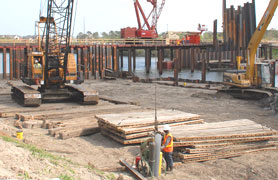
This picture shows actual disaster site work conditions and may not illustrate proper safety and health procedures.
Activity Description
- This activity sheet is for crane operators and their supervisors. It advises operators and associated response and recovery workers on steps they can take to protect themselves (and others) from hazards likely to be encountered during crane operation. This sheet should be used in conjunction with the activity sheet for the particular activity in which the heavy equipment is being used (e.g., building demolition, bridge repair).
- As a result of Hurricanes Katrina and Rita's (2005) high winds and floodwaters, many structures are unsound and in need of demolition or repair. To help restore the affected communities, many cranes will be used to demolish buildings and transfer materials or debris.
- Crane operators must be familiar with the equipment they are operating. Additionally, operators of cranes should refer to the Heavy Equipment and Powered Industrial Truck Use activity sheet and the Work Zone Safety and Traffic Control within a Work Area activity sheet for additional general recommendations (establishing and marking work zones, use of spotters, the need for backup alarms), which apply to all heavy equipment.
- Response and recovery workers conducting this operation may be employed by Federal, State, local, and private employers. Review How to Use This Matrix in the introduction for a discussion of how this information may apply to different workers.
About the Activity Sheet
This activity sheet does not provide an in-depth analysis of OSHA standards and regulations and cannot address all hazards. It does not increase or diminish any OSHA requirement or employer obligation under those requirements. It is intended as a guide and quick reference for employers and response and recovery workers. The Matrix captures major activities involved in hurricane response and recovery, highlights many of the hazards associated with them, and recommends beneficial work practices, personal protective equipment (PPE), and other exposure control methods. Employers must evaluate the specific hazards associated with the job/operation at the site where the work is being performed.
Employers are responsible for providing a safe and healthful workplace for their workers. OSHA's role is to assure the safety and health of America's workers by setting and enforcing standards; providing training, outreach, and education; establishing partnerships; and encouraging continual improvement in workplace safety and health.
The Hazard Exposure and Risk Assessment Matrix for Hurricane Response and Recovery Work provides a general overview of particular topics related to current OSHA standards. It does not alter or determine compliance responsibilities in OSHA standards or the Occupational Safety and Health Act of 1970, or the equivalent State Plan standards and requirements. Because interpretations and enforcement policy may change over time, you should consult current OSHA/State Plan administrative interpretations and decisions by the Occupational Safety and Health Review Commission and the courts for additional guidance on OSHA compliance requirements. Employers should modify their procedures as appropriate when additional, relevant information becomes available.
General Recommendations
Key Engineering Controls and Work Practices. See general recommendations document.
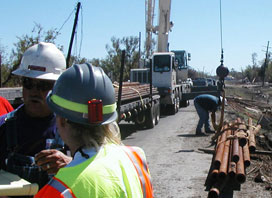
This picture shows actual disaster site work conditions and may not illustrate proper safety and health procedures.
Personal Protective Equipment. The general PPE is recommended for all response/recovery tasks/operations; only the additional PPE that may be needed for a specific hazard is noted below.
General PPE includes:
- Hard hat for overhead impact or electrical hazards
- Eye protection with side shields
- Gloves chosen for job hazards expected (e.g., heavy-duty leather work gloves for handling debris with sharp edges and/or chemical protective gloves appropriate for chemicals potentially contacted)
- ANSI-approved protective footwear
- Respiratory protection as necessary—N, R, or P95, filtering facepieces may be used for nuisance dusts (e.g., dried mud, dirt and silt) and mold (except mold remediation). Filters with a charcoal layer may be used for odors.
Recommendations Specific to Hazards Associated with Crane Use
Key Engineering Controls and Work Practices
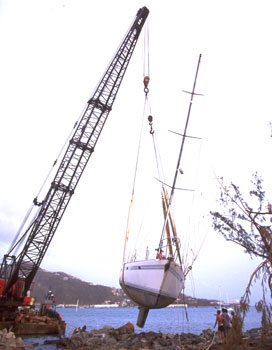
- Ensure that a competent person inspects all machinery and equipment before and during each use, to confirm that it is in a safe operating condition. A competent person is able to recognize existing and predictable hazardous conditions and has the authority to take prompt corrective measures to eliminate the hazardous conditions
- If observed during an inspection, ensure that deficiencies are repaired and defective parts are replaced before machinery and equipment is used
- Post any recommended operating speed, rated load capacities, or other instructions near the operator
- Position cranes on firm and level surfaces; use outriggers as needed
- Consult the crane load chart and do not exceed the rated capacity of the crane and rigging for the planned lift
- Use the hand signals prescribed by ANSI for the type of crane being used; post an illustration of the signals at the job site
- Ensure that the pathway is clear before executing a lift
- Maintain at minimum a 10-foot working clearance from power lines rated at 50 kV or less; increase this clearance by 0.4 inches for each 1 kV above 50 kV; where it is difficult for the operator to maintain the desired clearance by visual means, designate a person to observe clearance of the equipment and give timely warning for all operations
- Ensure that reciprocating, rotating, or other moving parts or equipment are guarded if capable of being contacted by workers
- Do not make any additions or modifications to the crane without written approval from the manufacturer
- When a mobile crane is mounted on a barge, ensure that the rated load of the crane is not exceeded, a loading chart is provided, and that the crane is positively secured
- Ensure that floating cranes and derricks used for wet debris removal meet the applicable design, construction, installation, testing, maintenance, and operation requirements set by the manufacturer
Key Engineering Controls and Work Practices
- Ensure that the cables of the crane were inspected within the past year by a competent person
- Take wire rope out of service when any of the following conditions exist:
- In running ropes, six randomly distributed broken wires in one lay or three broken wires in one strand in one lay
- Wear of one-third the original diameter of outside individual wires
- Kinking, crushing, bird caging, or any other damage resulting in distortion of the rope structure
- Evidence of any heat damage from any cause
- In standing ropes, more than two broken wires in one lay in sections beyond end connections or more than one broken wire at an end connection
Key Engineering Controls and Work Practices
- Inspect rigging equipment for material handling prior to use on each shift and as necessary during its use to confirm that it is safe; ensure defective rigging equipment is removed from service
- Ensure that rigging equipment is not loaded in excess of its recommended safe working load
- Ensure that rigging equipment, when not in use, is removed from the immediate work area so as not to present a hazard to workers
- Ensure that lifting accessories are marked to indicate the safe working loads and are proof-tested prior to use to 125 percent of their rated load
- Ensure that rigging equipment is not shortened with knots or bolts or other makeshift devices
- Pad or protect rigging equipment from the sharp edges of their loads
- Ensure that rigging equipment is not shock loaded
Key Engineering Controls and Work Practices
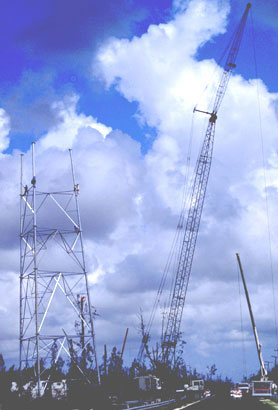
- Do not use cranes to hoist workers on a personnel platform, except when the erection, use, and dismantling of conventional means of reaching the worksite (e.g., personnel hoist, ladder, stairway, aerial lift, elevating work platform, or scaffold) would be more hazardous or is not possible because of structural design or worksite conditions
- Ensure that any hoisting of a personnel platform is performed in a slow, controlled, cautious manner
- Hold a meeting with the crane operator, signal person(s) (if necessary for the lift), worker(s) to be lifted, and the person responsible for the task and make sure that all the personnel-lifting requirements have been met prior to the trial lift at each new work location. Have a similar meeting for any workers newly-assigned to the operation
- Before personnel are lifted, conduct a trial lift with an unoccupied, equivalently loaded platform
- Ensure that the total weight of a loaded personnel platform and the related rigging do not exceed 50 percent of the rated capacity for the radius and configuration of the crane
- Ensure the platform is not loaded in excess of its rated load capacity
- Ensure that workers keep all parts of the body inside the platform during raising, lowering, and positioning
- Ensure that all eyes in wire rope slings are fabricated with thimbles
- When a wire rope bridle is used to connect the personnel platform to the load line, ensure that each bridle leg is connected to a master link or shackle in such a manner as to ensure that the load is evenly divided among the bridle legs
- Ensure that workers are not hoisted unless the hoist ropes are free of kinks, multiple part lines are not twisted around each other, the primary attachment is centered over the platform, and the hoisting system has been inspected to ensure that all ropes are properly stated on drums and in sheaves
Additional Personal Protective Equipment
- Personal fall arrest system including harnesses, lanyards, lifelines, connectors, anchorages, and anchor points (as needed)
Key Engineering Controls and Work Practices
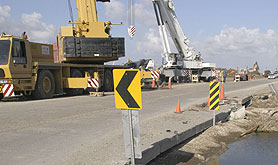
- See Work Zone Safety and Traffic Control within a Work Area activity sheet
Additional Personal Protective Equipment
- ANSI/ISEA 107-2004 compliant high visibility safety apparel and headwear
Key Engineering Controls and Work Practices
- See Heavy Equipment and Powered Industrial Truck Use activity sheet
Additional Personal Protective Equipment
- Hearing protection when working around potential noise sources and when noise levels exceed 90dBA. A useful "rule of thumb"-if you cannot hold a conversation in a normal speaking voice with a person who is standing at arms length (approximately 3 feet), the noise level may exceed 90 dBA
Key Engineering Controls and Work Practices
- If hazardous chemical containers are found or leaking materials are detected:
- Do not use spark-producing devices (e.g., engines, tools, electronic, and communications equipment) in the immediate area
- Take self-protective measures (i.e., move to a safe distance upwind) and contact hazardous material response personnel for evaluation/removal before continuing work in the area
Additional Personal Protective Equipment
- Evaluate the need to revise protective clothing, respirator, and glove selection
- Select any of the following potential hazards that can be associated with this activity in order to access relevant recommendations in the general recommendations document:
- Environmental hazards
Additional Medical Needs

This picture shows actual disaster site work conditions and may not illustrate proper safety and health procedures.
- Follow medical guidance and precautions outlined in the general recommendations document
Additional Training Needs
- Follow general site- and task-specific training guidelines as outlined in the general recommendations document
- OSHA equipment-specific training requirements
Related Activity Sheets
- Heavy Equipment and Powered Industrial Truck Use
- Work Zone Safety and Traffic Control within a Work Area
Other Resources and References
- 29 CFR 1926.251, Rigging equipment for material handling. OSHA Standard.

